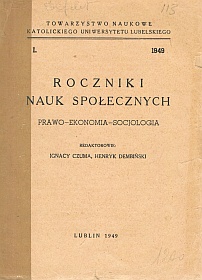Statut Bałtyku (Zarys problemu)
Abstrakt
Although the Baltic Sea is a „free sea" it is joined with the great oceans only by the Danish Straits and the Kiel Canal. It has therefore a complex of different problems, which being related together form „The Baltic Statute". The Danish Straits were governed exclusively by Denmark to whom the toll was paid, until in 1857 the said toll was bought off by all the concerned states. The second road is the Kiel Canal which passes through the territories of Schleswig and Holstein. By a far reaching policy the Germans succeeded in mastering Schleswig and Holstein in order to be able to build the Kiel Canal and to attain the superiority of their war fleet. In 1920 the Kiel Canal was opened to free navigation for all the states. The securing of freedom on this road and the neutralisation as well as the demilitarisation of Schleswig and Holstein would contribute to the safety of Denmark. On the east side of the Baltic this is accomplished by the Alland Isles, demilitarised in 1856 by a treaty which, with the agreements of more recent times, contributes to the maintaining of stability and peace. These two factors are the constant worry of the Baltic States; to maintain them declarations of neutrality on the Baltic were issued, attempts to neutralise it and endeavours to maintain the „status quo" were made. Germany and Russia were most concerned in maintaining the latter because of their Baltic acquisitions: Poland, Finland and Schleswig and Holstein. This found its expression in the guarantee agreement upon the „status quo” on the Baltic and the North Sea in 1908. Thus the partitions of Poland were confirmed once more after 136 years. Having shown the territorial changes which took place on the Baltic since 1920 and having dealt with the security of the sea in case of war based on the XIII th Hague Convention and the Stockholm declaration of 1938, the author passes to the common economic interests of the Baltic States. This community of interests results from a number of agreements in consequence of which the Baltic Sea is in certain regards an area controlled in common by several masters—the Baltic States. The convergence of many interests, although of different kinds, but all grouped around the Baltic, can cause the Baltic States to form a regional agreement in the frames foreseen by the Charter of the United Nations. A number of different questions which the author deals with are connected with each other so as to form the base for a work of peace called the „Baltic Statute”.
Copyright (c) 1949 Roczniki Nauk Społecznych

Utwór dostępny jest na licencji Creative Commons Uznanie autorstwa – Użycie niekomercyjne – Bez utworów zależnych 4.0 Międzynarodowe.


